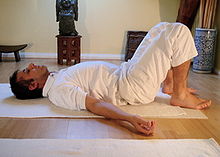Shavasana

Shavasana (Sanskrit: शवासन; IAST: śavāsana), Corpse Pose, or Mrtasana,[1] is an asana in hatha yoga and modern yoga as exercise, often used for relaxation at the end of a session. It is the usual pose for the practice of yoga nidra meditation.
Etymology and origins[]
The name comes from the Sanskrit words शव Śava, "corpse" and आसन Āsana, "posture" or "seat".[2] The alternative name Mrtasana is from Sanskrit मृत mṛta, "death".[1]
The earliest mention of this asana is in the 15th century Hatha Yoga Pradipika 1.32, which states in the context of a medieval belief system that "lying down on the ground supine, like a corpse, is called Shavasana. It eliminates tiredness and promotes calmness of the mind."[3][4]
Description[]
Shavasana and some sitting asanas maintain the balance between relaxation and meditation (two key components of yoga) by their equal input of physical stimuli.[5]
Shavasana is performed on the back with the legs spread as wide as the yoga mat and arms relaxed to the side, and the eyes closed. The whole body is relaxed on the floor with an awareness of the chest and abdomen rising and falling with each breath. During Shavasana, all parts of the body are scanned for muscular tension of any kind. Any muscular tension the body finds is consciously released as it is found. All control of the breath, the mind, and the body is then released for the duration of the asana. Shavasana is typically practiced for 5–10 minutes at the end of an asana practice, but can be practiced for 20–30 minutes.[1]
The asana is released by slowly deepening the breath, flexing the fingers and toes, reaching the arms above the head, stretching the whole body, and exhaling while bringing the knees to the chest and rolling over to the side in a fetal position, drawing the head in the right arm. From here, one can push up into a seated position. Drowsiness or restlessness of the mind while in Shavasana may be counteracted by increasing the rate and depth of breathing. While in Shavasana, it is important to be in a neutral position.[1]
Variations[]

Shavasana can be modified by bending the knees, keeping the feet hip-width apart, to allow people with low back pain to recline comfortably.[6] The variation can also be used by practitioners who find it hard to relax when lying flat.[1]
Effects[]
Shavasana is intended to rejuvenate the body, mind, and spirit. In the pose, the breath deepens, and the stress of the day is released. The yogi forgets all other thoughts and surrenders any psychological effort. While in Savasana, yogis slip into blissful neutrality and reflect on the practice.[7] Comfort is essential in the pose; the slightest point of discomfort can be endlessly distracting. Shavasana is a good way to reduce stress and tension.[8]
Yoga nidra[]
Yoga nidra ("yogic sleep") meditation is often practiced in Shavasana.[1]
See also[]
References[]
- ^ a b c d e f "Corpse Pose". Yoga Journal. Retrieved 11 April 2011.
- ^ Sinha, S. C. (1996). Dictionary of Philosophy. Anmol Publications. p. 18. ISBN 978-81-7041-293-9.
- ^ Hatha Yoga Pradipika, Chapter 1, verse 32
- ^ Mallinson, James; Singleton, Mark (2017). Roots of Yoga. Penguin Books. pp. 108–109, "Hathapradipika. The first teaching of non-seated postures as part of hathayoga". With another translation of verse 1.32. ISBN 978-0-241-25304-5. OCLC 928480104.
- ^ Singh, G.; Singh, J. (2010). "Yoga Nidra: a deep mental relaxation approach". British Journal of Sports Medicine. 44 (44(S1)): i71–i72. doi:10.1136/bjsm.2010.078725.238.
- ^ Swanson, Ann (2019). Science of Yoga : understand the anatomy and physiology to perfect your practice. DK Publishing. p. 187. ISBN 978-1-4654-7935-8.
- ^ "The Purpose of Corpse Pose". Yoga Journal. Retrieved 16 January 2018.
- ^ Physical Education Class – XII. Rachna Sagar. p. 64. ISBN 978-81-8137-350-2. Retrieved 11 April 2011.
Further reading[]
- Iyengar, B. K. S. (1 October 2005). Illustrated Light On Yoga. HarperCollins. ISBN 978-81-7223-606-9.
- Saraswati, Swami Janakananda (1 February 1992). Yoga, Tantra and Meditation in Daily Life. Weiser Books. ISBN 978-0-87728-768-1.
- Saraswati, Swami Satyananda (1 August 2003). Asana Pranayama Mudra Bandha. Nesma Books India. ISBN 978-81-86336-14-4.
- Saraswati, Swami Satyananda (January 2004). A Systematic Course in the Ancient Tantric Techniques of Yoga and Kriya. Nesma Books India. ISBN 978-81-85787-08-4.
- Reclining asanas
- Medieval Hatha Yoga asanas


